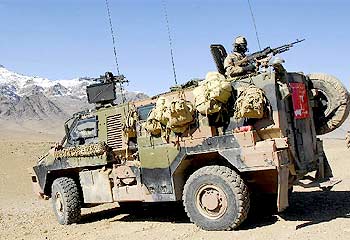
THE Defence Department has been ordered to find $10 billion worth of savings over the next decade, including possible staff cutbacks, as the Rudd Government tries to exert greater financial discipline across big-spending departments.
===
As Andrew Bolt notes;
Four days ago:
THE Howard government left the defence budget in a mess and suffering a shortfall of up to $6bn over the next 10 years, Defence Minister Joel Fitzgibbon said today.
Today:
THE Defence Department has been ordered to find $10 billion worth of savings over the next decade, including possible staff cutbacks, as the Rudd Government tries to exert greater financial discipline across big-spending departments.
These people are making it up as they go along.
1 comment:
Defence told to shed $10bn
from news.com.au
THE Defence Department has been ordered to find $10 billion worth of savings over the next decade, including possible staff cutbacks, as the Rudd Government tries to exert greater financial discipline across big-spending departments.
The crackdown on spending could force a cut in the department's 20,000-strong civilian workforce, which has ballooned by almost 4000 personnel, or more than 20 per cent, since 2001.
The Government has guaranteed that the Defence budget will continue to grow by 3 per cent a year in real terms.
The department's non-civilian operations are also insulated from the budget cuts sought across the public service by Finance Minister Lindsay Tanner, including the 3.25 per cent "efficiency dividend" affecting every other department.
But Defence Minister Joel Fitzgibbon ordered the crackdown on costs within Defence after being advised of massive blowouts in projected spending, including equipment, personnel and operating costs.
Mr Fitzgibbon admitted this week that the $22 billion Defence budget was "a mess", with the cost of operating and sustaining the defence force "alarmingly underestimated and underfunded".
He said the shortfall in operating and personnel costs over the next decade could be up to $6 billion, and acknowledged that some major equipment projects were proving "more than problematic".
An internal Defence Department memorandum obtained by The Weekend Australian - dated March 20 and signed by departmental head Nick Warner and defence chief Air Chief Marshal Angus Houston - says Defence must identify savings of $1 billion a year, or up to 5 per cent of its annual budget.
The memorandum was sent one day after Kevin Rudd this week announced the appointment of new heads to the army, airforce and navy, and extended Air Chief Marshal Houston's tenure by three years.
The pair identify significant financial challenges, including: expected new cost pressures flowing from the imminent 2008 defence white paper; the already-identified shortfall in personnel and operating costs; and the management of new capital equipment projects, as well as weapons, munitions and explosives.
"Following extensive discussions with the minister, we have decided that to meet these challenges we must find efficiency and economy opportunities in the order of $10 billion over the 2008-18 Defence Management and Finance Plan," they said.
"Given the size of our funding base and its commitment to future growth, the Government expects us to identify significant savings to fund higher priority capabilities. Our aim is to instil an enhanced culture of efficiency and economy in Defence. As we become more efficient there may be a need for less Australian Public Service staff."
But analysts said it would be impossible for Defence to realise the current 10-year, $50 billion capability plan, including the purchase of new warships and fighter planes, even if the 3 per cent pledge was honoured by the Government.
Defence will not be able to afford all its planned major new acquisitions over the next decade, led by the $16 billion joint strike fighter.
Defence costs across the board, including equipment, operating and personnel costs, have been increasing at well above the rate of inflation.
The Defence Department is already subject to the Government's 3.25 per cent "efficiency dividend" but this applies only to civilian administration and not to defence force operations, meaning only $2.4 billion of the $22 billion Defence budget is affected.
The Government has capped recruitment of civilians into the ADF as it seeks to cut expenses. Hiring of uniformed staff remains unaffected, but the ADF has been restricted to recruiting within the federal public service to fill its civilian vacancies.
In their memo to staff, the defence chiefs acknowledge that finding $10 billion worth of savings will be tough.
"To meet these challenges Defence must find efficiencies which free up resources. We need to identify lower priority activities and ask whether they are as important as new priorities. We must challenge the need, scope and cost of new priorities," Mr Warner and Air Chief Marshal Houston write.
They say that any civilian personnel cuts would be managed in line with Australian Public Service Commission guidelines.
Post a Comment